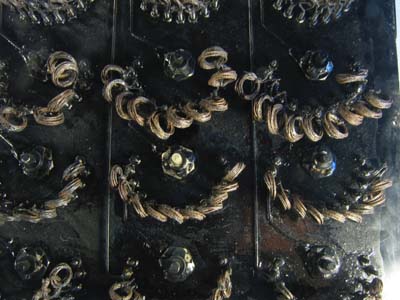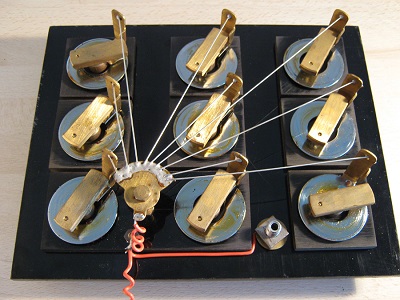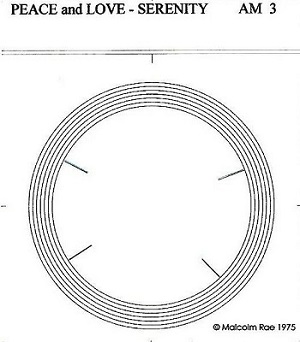“The Good, the Bad and the Ugly”
Cue theme music by Ennio Morricone
(Just kidding.)
My initiation into radionics was via a Copen Model Y Portable instrument, built sometime in the mid-1970s, and has also previously been part of the Borderland Sciences collection. I went on to acquire more classic Copen instruments, and my radionics practice centred primarily on the use of Copen devices. Part of this process of the exploration into radionics brought about a fascination with the rates. What did those numbers signify, and how were they derived? What meanings might they have, and what is their relationship to the material world with which we are familiar?
In some sense, I had unwittingly immersed myself into a world of Base 10 numerical rates. And not just any Base 10 rates, but Copen rates. I quickly learned that there were alternative Base 10 systems, from other sources, apparently applicable to other apparently similar potentiometer (variable resistor) based instruments, but of different design to Copen’s. And so I embarked on a rates hunt, naively thinking that the more I had, the better armed I would be somehow.
Together with the various Copen instruments, I had acquired several Copen rates books. But then I received my first non-Copen rates book, a book compiled by Yvon Combe that also included Base 10 rates, from which I eagerly (with, I have to say, some justification) experimented on my Copen instruments. The results did not meet my excited expectations, which got me contemplating the design, purpose and intention embodied, not only in the rates, but in the instruments as well.
In relation to some other potentiometer based instruments, the Copen devices are restricted, by design, to Base 10 rates. However Base 10 is not the only rates system suitable to the potentiometer type instrument. The other common and applicable rates systems are Base 44 and Base 336. (Obviously I’m not including the Hieronymus capacitor based system here.)
It is obvious why Base 44 cannot be used with an instrument designed specifically for Base 10: On such devices the dials are calibrated for 0-10, and not 0-44 that Base 44 requires.
However, despite its name, Base 336 does not use a numerical range up to 336, and I am yet unsure as to why it was so named. In theory it is possible to use Base 336 rates on a Base 10 instrument, but I personally do not recommend it, for reasons I shall elaborate below.
First, to make it clear what these three systems are:
• Base 10 corresponds to numbers between 0 and 10.
• Base 44 corresponds to numbers between 01 and 44.
• Base 336 corresponds to numbers between 1 and 9.
Base 10 is the earliest rates development, which was created by Dr Albert Abrams’ use of decade resistor boxes to measure, what he believed, was some kind of resistance in the human body to disease. Thus his devices were calibrated between 0 and 10.
A direct line of development of the Base 10 rates system may be traced precisely from Abrams to Ruth Drown and on to Bruce Copen (who expediently “borrowed” Drown’s rates).
George De la Warr, meanwhile, developed more or less in parallel a different Base 10 system for his devices that (at least initially) didn’t use potentiometers, or anything that produced an appreciable electrical change such as resistance at all. Instead, De la Warr was exploring a kind of vibrational resonance or harmonics, rather than “shaping” the energetic or informational flow via variable resistances. (Nevertheless his later instruments made use of potentiometers and more radionically “conventional” wiring, possibly for financial reasons.)
As an aside, there was a slight, and similar, variance in the Base 10 concept which was common to both Drown’s and Delawarr’s rates systems. Both of them used the first (or master) dial calibrated 0-100. Thus the first two digits of the rates correspond to the setting on the first dial. This principle was not followed by Copen, whose method required rates to finish on the last dial rather than starting from the first.
Meanwhile Malcolm Rae, intent upon improving the informational “resolution” over Base 10, created the Base 44 system, and quickly went on to create the Magneto-Geometric cards (having a circular diagram with radial lines defining the informational pattern, rather than utilizing numerical rates). Following on from Rae, Yvon Combe converted the geometrical patterns of the cards into corresponding Base 10, Base 44 and Base 336 rates (this latter being a rates system that Combe himself created).
Hence all Base 10 rates are not created equal. The Drown/Copen rates may be considered linear, while the Combe rates are pattern-based. Yvon Combe has written that the Base 336 system that he developed is a combination of Base 10 (which he referred to as “digital”) and the magneto-geometric patterns of Rae’s cards. This being so, Base 336 might, perhaps, be to be a more “complete” or “complex” rates system, embracing more influences and patterns of information despite their apparent simplicity.
Further to all of this, there are various understandings held by some, that the different rates resonate differently with the subtle energies or occult anatomy. From the above historical evidence, the different rates systems were gradual, incremental developments or advancements within the field of radionics, by different people at different times, and were not developed in conjunction with each other with the purpose of addressing the different subtle bodies.
Nevertheless, an understanding has evolved regarding rates vs subtle bodies. While there is no outright consensus, the following is what is what, I believe, Yvon Combe proposed:
• Base 10: resonant with the vibratory field of the physical/etheric body.
• Base 44: resonant with the vibratory field of the emotional/astral body.
• Base 336: resonant with the vibratory field of the mental body.
This delineation will be slightly different to what some others adhere to, so I feel that it is fine to follow what feels harmonious with one’s own practice and experience.
Unfortunately, there is a fly in the ointment. And this is that most instruments are not designed, or are not intended, to use all three of these rates systems.
From my personal experience, I have not received satisfactory results when using Combe’s Base 10 rates on Copen instruments – and these experiences are from some time before I knew much, if anything, about how the various rate systems were developed by Yvon Combe. However, from anecdotal evidence and my intuition, I feel that Base 336 is very powerful and effective, and I wish to use these rates more frequently.
As I implied above, until recently I have used primarily Copen instruments, together with some of my own construction, but none of which are designed for anything other than Base 10. Therefore I am currently constructing an instrument specifically intended for Combe’s rates.
As diversity does not exist separate from, or outside of, completeness or totality, I also feel that all parts, even the component parts in art of radionics, exist in a whole form: inclusive of instrument design, rates and other information, together with the designers, the practitioner and the subject. The thoughts and intentions of the practitioner AND of the instrument and rates designers have an influence on the manifested reality we are designing via the practice of radionics. This work, and indeed this world, are, of course, the play of the totality of consciousness.
“No one thing is superior to another, nor should any aspect be removed, slighted, or thought of as unworthy, lest the machine fail to function properly and as smoothly as intended.”
(Gregory Storozuk)
In conclusion, I will say that I don’t profess to have “cracked” radionic rates. However my understanding at the moment is that numerical rates are related to ratios and harmonics in some sense of those words; similar, perhaps, to how sacred geometry is a 2 dimensional representational glimpse into the workings of the Divine mind. Ruth Drown saw some sacred relationship in her numerical rates, through her studies in the Kabbalah – which is perhaps the subject of a future article.
I hope this article is of help, particularly if you are using a “resistor based” radionics instrument. Please feel free to engage in the conversation by leaving your comments below. I would love to hear your insights on these topics of rates and instrument design and purpose.










Very interesting. I learned a lot from this post. I didn’t know base 10 started at 0 but base 44 started at 1. I had heard of base 336 but knew nothing about it. I use Hieronymus instruments. Hieronymus rates are not thought to be associated with any specific part of subtle anatomy as far as I know. We are taught that we work on the energetic level and the effects work “down” into the physical. We do have rates for each of the subtle body layers so we can analyze or broadcast there.
I just did a quick look for base 336 information and I found a site that says that the plates used for setting the angles have 336 degrees total, thus the name. But this site also says that the rates go from 0 to 9 and not 1 to 9 so I don’t know how true this is. If true, this would explain why the rates don’t work well on Copen instruments.
Hieronymus rates are labeled 0 to 100 because this is the “percent enmeshed” the capacitor plates are. Some instruments have the dial labeled on the lower half too, from -99, -98, -97 and so on back around to 0. This is again reflective of the plate relationshps to each other. There is an alternate labeling for instruments made or influenced by Don Mattioda that goes from 101, 102, 103, etc back around to 0 instead. Most Hieronymus users use the Kelly system with negative numbers however.
Some operators believe that the “negative” rates are for spiritual things. I personally do not think this is true as such.
I do beleive that rates are a conventionalization, or symbol for our minds to use as a representation of a concept. The rate for calcium or the liver in any system means the same thing. Any differnce in quality between them is indicative of the clarity of the intent of the operator who scanned it and to a lesser extent the quality of construction of the instrument used in scanning it.
I have an original SE-5. They can use any rate system, but I have only used Hieronymus rates on mine so far.
I personally feel that the SE-5 is great for analysis, but not so great for broadcast. I also feel that the original SE-5 is better than the new SE-5 1000 or SE-5 2000 even though the new ones have much more sophisticated computers.
One thing I have always wonderd is do Base 10, 44, or 336 instruments have multiple “banks”, so to speak like Hieronymus instruments do? Can you set more than one rate at a time on these instruments? I have never been sure if the rows of dials on these instruments are “banks” or if it is just one long string of digits allowing one potentially long rate.
Thanks for your in-depth reply! Of course I am quite familiar with the Hieronymus system and various devices, although I’ve never used them. I’ve been primarily exposed to the British influences. The British embraced Ruth Drown’s Base 10 system while America went off on an Hieronymus tangent when Drown’s work was expunged by official US agencies.
Just to clarify, since the Base 44 and Base 336 systems were derived from Malcolm Rae’s magneto-geometry circular patterns, there is no “zero” when you divide the card into 44 segments to derive the rate. 1 is the first number, just as there is no 0 on a clock face.
Conventionally, Base 10-type instruments don’t have banks, as Hieronymus machines can. There are exceptions of course, although uncommon. In particular, the Base 44 instruments that Malcolm Rae built, before his concentration shifted exclusively to the card-based system, had switchable banks of dials like a multi-bank Hieronymus.
With the rates that Combe derived, it is possible to use several rates on the same bank by leaving a dial set to 0 between each rate, since there is no 0 in his rates, 0 thus being a “null”.
As for 336 representing the angle of rotation of the dial, that must be nonsense, because potentiometers don’t have a rotation angle of more than 300 degrees, commonly around 270 degs.
Risultati della traduzione
In reality it is not true that the base 44 rates are derived from Malcolm Rae’s papers. Base 44 installments are not Yvon Combe’s creation. Base 44 rates are Malcom Rae’s invention and were used with his “base 44” instrument (instrument that had 3 rows of 8 pots each), which could work with both De la warr and Drown in base 10, both with its base 44 installments. Malcom Rae’s base 44 installments are less numerous than De la warr’s base 10 installments. It’s a simpler system to use and more precise than base 10. The cards are his later discovery, first he created the “base 44″ instrument and searched all the rates for that instrument, and only later did he create his own ” cards”, which were initially used exclusively with potentisers. Once he discovered that by pulsing the “magnetic signal” with a simple square wave generator, he was able to obtain excellent results even in remote treatments, his instruments that used magneto-geometric charts thus began to be built by default with the square wave generator inside them. As far as Yvon Combe’s installments are concerned, I can say that personally I have never had good results, so I decided to discard them, while instead regarding the subdivision of the installments made by Combe, according to which some types of installments would mainly work on the physique, others on the mental and others on the emotional, I don’t agree, I don’t think there is any differentiation at this level between these different types of installments, but clearly this is only my opinion.
Just for clarity, I never claimed that Base 44 rates were Yvon Combe’s creation, but that Combe derived his rates (which did include Base 44) by charting or graphing Malcolm Rae’s Magneto-Geometric cards. Rae was working with Base 44 rates before he invented the cards. I have two of Malcolm Rae’s Base 10/44 instruments (the one with 3×8 dials) which he made prior to concentrating on his card system, so I’m aware of Rae’s evolutionary development. I do state in the article that Rae developed the Base 44 rate system before he invented and developed his card system.
Finally, I included apparent differences between the Base 10, 44 and 336 rates (which in theory MAY correspond to the physical, mental and emotional levels) because some people do ascribe these qualities to those rates. I wasn’t passing judgment upon those claims in any way, and in fact wrote that “I feel that it is fine to follow what feels harmonious with one’s own practice and experience.” In other words, do what feels right for you to do.
I hope this clarifies.
Probably the translation I made with google (I don’t read well in English), made me misunderstand. Anyway congrats on your base 44s 🙂 As for Combe’s base 44 installments, I still decided to try them again and see what happens. They are particular installments, because he necessarily had to set them in ascending order, however since Rae did not find many installments of the base 44 remedies, I would like to try, in addition to the classic use of Rae’s installments, for example pathology compensated on the organ, see what results would be obtained by directing Combe’s 44-based remedies on Rae’s organ rates, is something I intend to experiment. Merry Christmas and a Happy New Year 🙂
Thanks for the kind wishes Duccio! Best of luck with your experiments too. 🙂
Combes rating of base 10 doesn’t make any sense..rather if u can see the potentiometer from 1-9 and 1-10 for base 336 and base 10 , we can see that rates given against 336 rates in combes list doesn’t match the positions , not only these but are much repeated as well.
Yvon Combe has passed away some time ago, and wouldn’t reveal to me the source of his Base 336 rates. I believe that his Base 336 rates were computer generated, whereas his Base 10 rates were derived from Malcolm Rae’s cards.
“Ruth Drown saw some sacred relationship in her numerical rates, through her studies in the Kabbalah – which is perhaps the subject of a future article.”
Totally looking forward to that one… i have studied and feel very comfortable with the kabbalah so i would love to look at radionics through the kabbalistic lense.
Which book or publication does she speak about it?
Also any specific source to finding (physical copies prefered) radionics publications? or do you go around scouring second hand bookstores? Thank you for sharing!
Ruth Drown was introduced to Kabbalah through the book “The Kabbalah Unveiled” by MacGregor Mathers. It’s not an easy read, but that was her initial inspiration. “The Mystical Qabalah” by Dion Fortune would be a better intro these days. I need to absorb myself more in Kabbalah to really feel my way into its application to radionics. Nevertheless I certainly feel that there is cosmic significance in numbers, and patterns, as demonstrated via Gematria and sacred geometry. Without Ruth Drown, radionics may have been ultimately overwhelmed by materialist, reductionist scientism.
Without counting, I have about 50 books on radionics. I haven’t had much luck finding radionics books in secondhand shops, although I have found a couple. One of the better sources would be abebooks, but if there are specific and obscure titles that I’m wanting, I just search around online over weeks/months/years until (with luck!) it pops up somewhere. In the past I have avoided amazon and USA dealers as often as possible, because cost of delivery to where I live is almost always many times more than the price of the book! Good luck in your search.
Thank you so much for your thorough reply!
I can make a guess at the relation of kabbalah to radionics… one obvious guess being a base ten system might refer to the ten sephirot (although some say actually there are 11, 12, 13 or even unlimited sefiroth…
I feel inspired to make a machine where each dial represents a sephiroth arranged in the shape of the kaballah tree… then you would have symbolically, each sephiroth (which has its own attributes) which can tune itself fractally in that each sephiroth dial also contains all other spheres… therefore say one sphere needs more aspects of another then one could tune say gevura(power) with chesed(mercy)…
This is all getting way far ahead of myself tho… first i wanna make a simple 3 pot device…
I have read some or all of each of the books u mention on kabbalah… what i would like to read is if there is anywhere ruth drown explains how she relates radionics/radio-therapy to kabbalah. I can draw many connections between the two however would love to know what she was thinking.
Thanks! I am so excited for my first build, will be soon…
I look forward to hearing of your radionic adventures. And I love the concept of an instrument based around the Kabbalistic tree! This really resonates with me.
We can’t know for sure what precise connections Ruth Drown made between Kabbalah and radionics; it was probably more inspirational than specific details. I’m going to go back through my notes and books about Drown, and chat with a couple of people before I write an article. I’m guessing that it may be brief, and certainly not definitive! Drown published a series of newsletters on her “Radio Therapy” but they are rare and I have never seen them (should any in fact survive!). They may contain very useful info… If you or anyone else reading this can help out, please drop me a line!
My path into radionics started a few years back when i was fortunate enough to discover two original drown instruments buried in the back of an antique shop (one of the two being her radio-vision camera) just outside of Hollywood, CA. I hadn’t a clue what the things were but being an audio engineer, i was intrigued by the 9 potentiometers wired in series in addition to seeing a vacuum tube for the very first time in my 25 years of life I couldn’t leave with out them. The owner of the store said he acquired them at the estate sale of the inventors daughter. There was a piece of paper with the rates for the 3 fundamentals of alchemy written by hand and a copy of her Radio Vision pamphlet inside of the storage compartment. Anyways the whole point to my brief anecdote is that the 2nd of the two devices i mentioned had the 9 pots arranged in the same formation as the Kabbalah tree of life, the well on one end and the master dial being on the other. I’d be happy to share photos if there is a way for me to do that.
Hi Rezn8s, your comment passed me by for awhile, sorry about that.
I’d be happy to share your photos in separate article, if you could email them to me. They will prove very educational!
Many thanks!
If we want to go for a simplest circuit two plates with three dials
…say base 10, …what do we ask for power of those potentiometers (will it be 10 ohms or 1k ohms) ..or another power..from an electronics shop..
The rating doesn’t matter. Different builders have their own preferences. The 10 ohms potentiometers are probably difficult to obtain, but 1k ohms will be readily available and suitable to your needs. Some people use 10k pots. For myself, I use 1k ohms potentiometers in my builds.
A radiônica não é recente e ela não surgiu no início da década de 1900. Alguns acreditam, inclusive, que a radiônica surgiu a muitos séculos atrás.
Na verdade no século 13, Muhammad ibn Khutlukh al-Mawsili criou um aparelho cuja inscrição na frente diz: “Eu sou o revelador de segredos; em mim há maravilhas de sabedoria e coisas estranhas e escondidas.”
Você pode encontrar o dispositivo na Sala 34 do Museu Britânico em Londres, parte da Coleção “Mundo Islâmico”.
Esse dispositivo tem várias imagens e segmentos da cabalah.
Quem sabe esta máquina tenha sido a inspiração!
I would also like to hear more about Ruth Drown and her view on the Kabbalah and how it relates to her rates. I don’t know much about her.
I don’t know how rates are constructed in other systems, but with Hieronymus rates, you put a sample or witness for what you are looking for in the well, and stroke the rub plate while rotating the left hand dial until you get a stick. Repeat for the right hand dial. Repeat again if you need a second or third bank for the rate. Pretty straightforward.
However I do think that there is something more than that behind the rates. I think they are more malleable than people realize. I’m not sure how to explain it, or if I really understand it yet. I do see “patterns” in some places in some ways in the numbers that come up or don’t come up in rates.
I think that more cross pollination (so to speak) between operators of different systems would be a big benefit to all.
Thanks again for your comments. I hope to put together some info about Ruth Drown soon.
“Cross pollination” between different systems isn’t always possible, of course. You’ve noticed that my focus is on potentiometer-based instruments. Hieronymus rates are of course technically incompatible with this, although it is my understanding that Caroline Connor (a radionic practitioner and teacher) simply takes a Hieronymus rate and breaks it down into component digits which she uses as Base 10 rates. Peter Kelly (father of Ed Kelly who still builds the KRT Hieronymus instruments) created Hieronymus rates from Delawarr Base 10 rates by interfacing the two instruments and dowsing the corresponding rates.
Rates aren’t an exact “thing” in themselves, of course. Some people use Base 10 rates from Sulis, Combe, Copen/Drown, Delawarr, and even non-radionic numbers such as Grabovoi and Mears numbers, all on the same instrument successfully. As for me, I’ve found that it is beneficial to have some kind of harmony or intelligent complimentary design that unites it all as a “system”, as you’ve noticed from my articles. I’m not sure if this result is due to some variable that is inherent in the operator, like a kind of “personality trait”.
That being said, I think that numbers are a part of the “intelligent design”, that being cosmic principles revealed through, for example, Kabbalah. And if you look at Ruth Drown’s rates, they reveal something of a pattern; for example different rates that refer to a related part of the body may include a common sequence of numbers, whereas some rates created today are a string of apparently disconnected numbers from a computer or random number generator. Nothing wrong with that, but it is a different thing altogether, while of course inseparable from the “intelligent consciousness” that holds the cosmos in order.
By cross pollination, I meant an exchange of ideas and pratices. I use Hieronymus instruments, and much of what you and I do, for example is similar. Some procedures, protocols, and philosophy are different (as far as I can tell), but I think operators of differnt systems could learn from each other.
I agree with you about rates not being an exact thing. And you are seeing the same thing I am when you talk about numbers being part of intelligent design and that seems to be reflected in rate “patterns”.
I didn’t know that Croline Connor uses Hieronymus rates that way, but I’m not really suprised that it works.
About the Grabovoi numbers, I read that he used a radionic instrument to determine them, so it seems like they basically are rates. He is just giving non radionic operators a way to use radionic rates. I’ll have to look up the Mears numbers. I’ve never heard of them before.
Looking forward to your information about Ruth Drown.